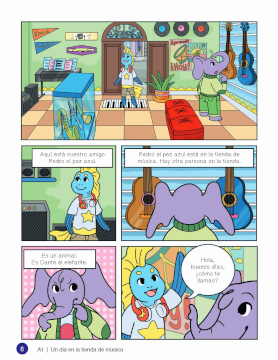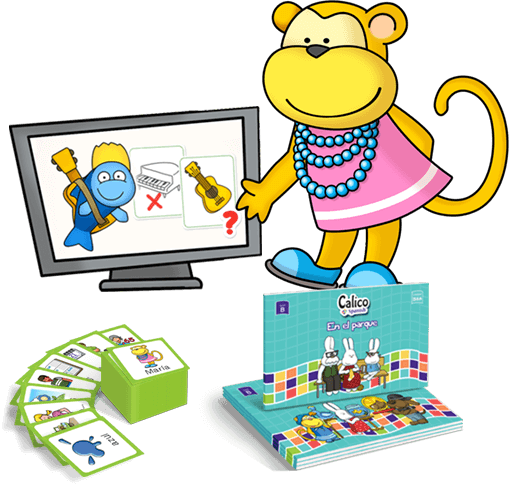Calico Spanish, Levels A through D, is an introductory online Spanish course for children in kindergarten through sixth grade. While children who have not yet begun to read can learn a great deal from the lessons by just watching and listening, they should be able to write (or copy words) and recognize written Spanish words to be able to participate in all of the activities. The content gradually becomes more difficult. Ideally, you would start Level A with a child in kindergarten or first grade, completing the four levels over four or five years.
Each level of Calico Spanish has eight multi-part lessons. Level A has lessons for 96 days, Level B has lessons for 93 days, Level C has lessons for 88 days, and Level D has lessons for 90 days. You can complete one level per school year by doing Spanish lessons just two or three days a week. However, since this program includes many fun activities, your children might enjoy this so much that they want to do Spanish every day!
The colorful lessons feature cartoon characters (e.g., a blue fish with yellow hair) that teach vocabulary related to topics such as family members, food, clothing, and items in a home. Using a conversational, multi-sensory approach, the course incorporates instructional videos, flashcards, music videos, games (e.g., "I spy..."), activity sheets, storybooks, posters, and interaction to teach children an introductory vocabulary. Children learn to speak Spanish primarily by listening and responding. They learn to read and write Spanish to a much lesser extent. If they are able, they can read along with the videos, flashcards, storybooks, etc. But if they can't read yet, they can still learn by listening and watching. While the activity pages require drawing and some writing, the amount of writing is very low, even in Level D.
As I mentioned, Calico Spanish uses a conversational approach. While the program teaches specific vocabulary words, the dialogues and stories generally include additional words that students have not yet learned—a very gentle, immersion approach. Students will not always be able to figure out what all of the words mean, but they will gradually understand more and more.
The program uses a large amount of repetition, repeating vocabulary words in different contexts so that children hear the words over and over. Lessons begin with review of the previous day's lesson. All of the games and activities reinforce learning, requiring oral rather than written responses most of the time. Students do not enter anything into the computer, so the program does not track student progress.
The online lesson components—instructional videos, music videos, storybooks, and flashcards—are laid out in the exact order you will use them. Even so, you can skip around within a lesson, or go back to other lessons if you wish to do so.
Calico Spanish requires some advance preparation for the games and activities, but the bulk of the teaching is done by the online resources. Parents or teachers will lead students through the lessons, interacting with them as directed.
Near the beginning of each day's lesson is a link to its lesson guide which can be viewed on the screen or printed out. Even though you and your child can just follow along with the parts of a lesson on the screen most of the time, the lesson guides explain grammatical points and sometimes provide instructions for activities that will be done off of the computer. Some of the activities or topics found only in the lesson guides are essential, while grammatical points can be presented at your discretion.
Posters are another helpful component of the program since children will be using them as quick reference tools. (I highly recommend either purchasing them or printing them out in color.) For example, Level C has a poster showing rooms in a house; the rooms themselves and some items, such as la mesa (the table), are labeled. These posters help children construct their own dialogues using words from the posters.
Lesson components such as flashcards, posters, and activity pages are linked directly within the lessons, and there are options to view them on-screen or to download them. Aside from the activity pages that must be printed out, it's up to you whether to download or print any of the files. All course components, including the instructional videos, can also be purchased as physical products for those without online access or who want physical products for other reasons. Calico Spanish is so well designed as an online course that I would recommend the online option in most cases. Still, some families might find it more practical to buy pre-printed flashcards, posters, or activity books.
A huge resource section on the Calico Spanish website has many lesson components grouped by type for easy access. For instance, you can find all of the music videos under one tab and all the instructions for games under another tab. So if you have a child who loves to learn by watching the music videos, you can easily find all of the ones from past lessons in one place. This makes it easy to review using your child's favorite learning methods.
You will need to supply some additional items on your own, such as resources needed for games, a stuffed animal, and crayons, but these items are likely already on hand.
 Calico Comics
Calico Comics
The cartoon characters in Calico Spanish are featured in four new comic books that correlate with the program. Their titles are Somos amigos, Los amigos adventureros, Adventuras de la vida, and Exploramos Mexico. They serve as readers to reinforce what students are learning. The comics are integrated into the online lesson plans, and they are also available as printed books that might entice children to read on their own.
Summary
Calico Spanish makes it easy for parents and teachers who do not know Spanish to help children learn the language. A class group or family can easily work together. In fact, I recommend group learning if possible since that will make the practice conversations and game playing even more fun for all.
A seven-day free trial (that does not require a credit card) gives you sufficient access to check out the program before subscribing.








